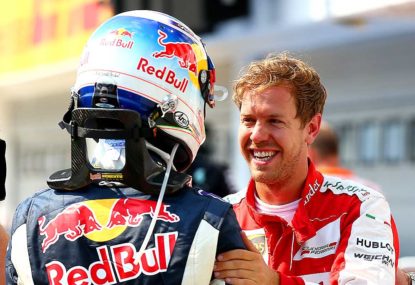The IndyCar Afterburn: The pitfalls and pinnacles of Long Beach 2024
The Long Beach Grand Prix is the Monaco of American motorsport, and this past weekend, the IndyCar Series reminded everyone exactly why. We witnessed…

Saturday, 4 October 2014. Japan’s fourth-tier Super FJ series is buzzing around the Suzuka Circuit in its first qualifying session of the weekend, but few in F1 circles are paying attention, instead fixating themselves on the racing implications of the impending Typhoon Phanfone.
At 9:52AM, away from the predictability of another Formula One qualifying day, a purple-clad member Red Bull Racing media team clicks ‘send’ on an unscheduled press release.
With every ping in the inbox of an F1 journalist, the serenity of the morning turns increasingly tempestuous, because the email, headed in all caps, opened with a devastating lead sentence: “Sebastian Vettel has advised us that he will be leaving Infiniti Red Bull Racing at the end of the 2014 season”.
Seismic movements in the Formula One driver landscape are rare, and few come larger than a four-time world champion leaving the team that delivered him all of his success. Those members of the press still taxiing to the circuit, one of whom was this writer, might be forgiven for giving his driver a hurry-up.
The pieces slowly fell into place. Vettel had long been rumoured to have a “pre-contract” with Ferrari to join the team when he felt his Red Bull career had peaked. Meanwhile Fernando Alonso was demonstrating the caginess of an outbound man; supposedly after a verbal confrontation with new team principal Marco Mattiacci.
When Red Bull Racing boss Christian Horner cheekily blabbed that Vettel would be dressed in red in 2015, though no official announcement came until almost two months later, the long-held theories proved irresistible. It was finally, really, happening.
“There are a lot of fairytales about Ferrari and how it feels to drive a red car,” Vettel enthused after driving a Ferrari F1 car for the first time at Fiorano, “and in the end I can only confirm these fairytales”.
But with an assortment of answers suddenly delivered, new questions posed themselves: if Fernando Alonso, regarded as perhaps the best driver on the grid, couldn’t will the woeful 2014 Ferrari to any higher than fourth in the constructors standings, what hope would Sebastian Vettel have at restoring the famous red team to the podium? After all, this was the man who spent much breath describing his discomfort in the new generation of cars.
Indeed, with Vettel having been comprehensively beaten by new teammate Daniel Ricciardo in 2014, some commentators remarked that Ferrari was swapping their dominant number one driver for a second number two.
In cleaning out its staff from part of the way through 2014, starting with the power unit department and ending with Maurizio Arrivabene replacing Marco Mattiacci as team principal, Ferrari was preparing an answer — a car that was promising in pre-season testing, consistent at round one in Melbourne, and a race winner at round two in Malaysia.
“The team has been phenomenal, welcoming me the first day,” recounted Vettel on the top step of the Sepang podium. “I remember when the gate opened in Maranello it was like a dream coming true.”
The recovery was surpassing expectations; Sebastian Vettel’s fairytale was becoming reality.
The season delivered two more victories for the team-driver combination that proved most troublesome for the otherwise dominant Mercedes, with Vettel in with a shout of an unlikely second in the drivers championship until the penultimate round of the year.
The German revelled in it — the jovial nature of his character, absent in his downtrodden 2014 season, returned, particularly in his ribbing of the warring Mercedes duo at the height of their fractious relationship this year. Ferrari, too, thrived in having an in-car leader that filled it with optimism. Sebastian Vettel and Ferrari fit hand in glove.
“We had the annual Gestione Sportiva event with all the technicians, the mechanics, the sponsors, and the drivers earlier this month,” said Ferrari president Sergio Marchionne earlier this month. “Sebastian gave a speech entirely in Italian.
“Of course he learnt it by heart, but it was perfect … he did it very honestly, like the guy he is, with a great heart and a lot of attachment.
“He became more Ferrari, like a guy who has always been Ferrari.”
But success comes easy when the de facto goal is to be the underdog. In 2016 the challenge should be, and must be, immeasurably more difficult — only a credible championship tilt can be called a success for a team with the money, the history and, now, the momentum of Scuderia Ferrari.
If Sebastian Vettel can lead such a resurgence, that which was spoken of only sparingly while the parts began to assemble themselves in 2015 will become all but the official mission statement of Ferrari for the duration of the German’s tenure in Italy.
“It’s not just a story, it’s a true legend that exists, and it feels really, really special to become part of that and to be inside the car — to see the people coming, running to the track and trying to climb the walls to see the car,” Vettel recalled feeling on that first testing day at Fiorano in November.
“Looking back to the years when I was 11 or 12 trying to look over the fence and trying to see a glimpse of Michael [Schumacher] running on the track — well, today I was the one running.”
Sebastian Vettel — “baby Schumi”, as he was nicknamed in his junior career — has a mighty pair of shoes to fill. In 2015 he tried them on, but in 2016 he has an opportunity to take his first steps.